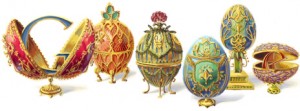Today’s Google Doodle celebrates what would have been the 166th birthday of Peter Carl Fabergé.
The image displays pieces similar to the famed Imperial Easter Eggs designed by the House of Fabergé. These eggs were given to members of the Romanov family each Easter, beginning with Alexander III, father to the unfortunate last Romanov ruler, Nicholas II. Nicky, as he was known to the family, purchased an egg each year for his wife Alexandra and his mother.
The eggs were masterpieces of craftsmanship and detail. They opened up to reveal surprises, though the first egg was deceptively simple: it appeared to be a plain white egg, but opening it revealed a gold hen with ruby eyes. The now missing surprises were an Imperial crown and a pendant.
One of the more exquisite pieces is the 1898 Lilies of the Valley egg, a beautiful pink enamel adorned with diamonds, pearls, and rock crystal. The surprises in this egg are the miniature portraits that appear when a button is turned. Nicholas II’s portrait is accompanied by those of his two eldest daughters, Olga and Tatiana. Fabergé designed this egg for the Czarina Alexandra, and he chose her favorite color (pink) and favorite flowers to accompany the pictures of her growing family.
To commemorate the services provided to the Red Cross by the family during World War I, Faberge created the Red Cross Portraits Egg, featuring a hidden panel of portraits of the women of the Imperial Family, including Nicholas’ wife, sister, cousin, and two eldest daughters.
You can visit the site here to see even more incredible pictures of the eggs that Fabergé created with the help of his workshop.
In 1918 the revolution came and the Bolsheviks nationalized the company, and Fabergé and his family fled the country, but he lived only two more years and died in Switzerland. His famous customers, the Romanovs, met a tragic fate in the Ipatiev House after abdication and exile. The eggs were scattered, sold, and hidden in the aftermath of the revolution, and now those interested can view his eggs and other masterpieces in various collections around the world.
